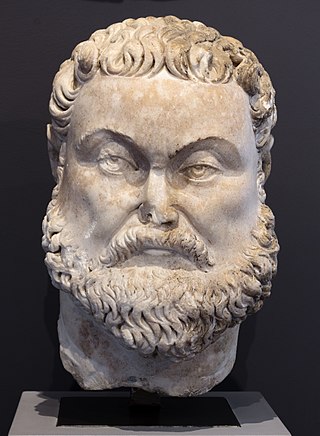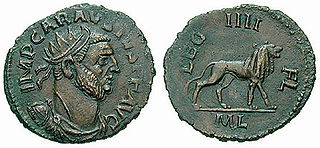
Diocletian, nicknamed Jovius, was Roman emperor from 284 until his abdication in 305. He was born Diocles to a family of low status in the Roman province of Dalmatia. Diocles rose through the ranks of the military early in his career, eventually becoming a cavalry commander for the army of Emperor Carus. After the deaths of Carus and his son Numerian on a campaign in Persia, Diocles was proclaimed emperor by the troops, taking the name Diocletianus. The title was also claimed by Carus's surviving son, Carinus, but Diocletian defeated him in the Battle of the Margus.
The 280's decade ran from January 1, 280, to December 31, 289.
Year 283 (CCLXXXIII) was a common year starting on Monday of the Julian calendar. At the time, it was known as the Year of the Consulship of Carus and Carinus. The denomination 283 for this year has been used since the early medieval period, when the Anno Domini calendar era became the prevalent method in Europe for naming years.
Year 282 (CCLXXXII) was a common year starting on Sunday of the Julian calendar. At the time, it was known as the Year of the Consulship of Probus and Victorinus. The denomination 282 for this year has been used since the early medieval period, when the Anno Domini calendar era became the prevalent method in Europe for naming years.

Numerian was Roman emperor from 283 to 284 with his older brother Carinus. They were sons of Carus, a general raised to the office of praetorian prefect under Emperor Probus in 282.

Maximian, nicknamed Herculius, was Roman emperor from 286 to 305. He was Caesar from 285 to 286, then Augustus from 286 to 305. He shared the latter title with his co-emperor and superior, Diocletian, whose political brain complemented Maximian's military brawn. Maximian established his residence at Trier but spent most of his time on campaign. In late 285, he suppressed rebels in Gaul known as the Bagaudae. From 285 to 288, he fought against Germanic tribes along the Rhine frontier. Together with Diocletian, he launched a scorched earth campaign deep into Alamannic territory in 288, refortifying the frontier.

Marcus Aurelius Carinus was Roman Emperor from 283 to 285. The eldest son of the Emperor Carus, he was first appointed Caesar in late 282, then given the title of Augustus in early 283, and made co-emperor of the western part of the Empire by his father. Official accounts of his character and career, which portray him as dissolute and incompetent, have been filtered through the propaganda of his successful opponent Diocletian.

In ancient Roman religion, Abundantia, also called Abundita or Copia, was a divine personification of abundance and prosperity. The name Abundantia means plenty or riches. This name is fitting as Abundantia was a goddess of abundance, money-flow, prosperity, fortune, valuables, and success. She would help protect your savings and investments. Abundantia would even assist someone with major purchases. She was among the embodiments of virtues in religious propaganda that cast the emperor as the ensurer of "Golden Age" conditions. Abundantia thus figures in art, cult, and literature, but has little mythology as such. She may have survived in some form in Roman Gaul and medieval France. Abundantia would carry a cornucopia that was filled with grain and coins. She would occasionally leave some of her grain or money at someone's house as a gift.

Marcus Aurelius Carus was Roman emperor from 282 to 283. During his short reign, Carus fought the Germanic tribes and Sarmatians along the Danube frontier with success.

Marcus Aurelius Mausaeus Carausius was a military commander of the Roman Empire in the 3rd century. He was a Menapian from Belgic Gaul, who usurped power in 286, during the Carausian Revolt, declaring himself emperor in Britain and northern Gaul. He did this only 13 years after the Gallic Empire of the Batavian Postumus was ended in 273. He held power for seven years, fashioning the name "Emperor of the North" for himself, before being assassinated by his finance minister Allectus.

The Roman emperor was the ruler and monarchical head of state of the Roman Empire, starting with the granting of the title augustus to Octavian in 27 BC. The term "emperor" is a modern convention, and did not exist as such during the Empire. Often when a given Roman is described as becoming emperor in English, it reflects his taking of the title augustus and later basileus. Another title used was imperator, originally a military honorific, and caesar, originally a surname. Early emperors also used the title princeps alongside other Republican titles, notably consul and pontifex maximus.

Marcus Aurelius Sabinus Julianus, known in English as Julian of Pannonia was a Roman usurper against Emperor Carinus or Maximian. It is possible that up to four usurpers with a similar name rebelled in a timeframe of a decade, but at least one of them is known by numismatic evidence.
The Prophetess is a late Jacobean era stage play, a tragicomedy written by John Fletcher and Philip Massinger. It was initially published in the first Beaumont and Fletcher folio of 1647.
Aper was a Roman citizen of the third century AD. First known to history as a professional soldier, he went on to serve as an acting provincial governor and finally became Praetorian prefect, under the Emperor Carus - in effect "vice principis". This rendered him hugely influential in the government of the empire - not excepting in matters of peace and war.
Lucius Caesonius Ovinius Manlius Rufinianus Bassus was a Roman military officer and senator who was appointed suffect consul twice, in around AD 260 and 284.
Marcus Aurelius was a name used by men from the Roman Empire and afterwards. The earliest so called was the emperor Marcus Aurelius. It became widely spread following the Constitutio Antoniniana issued by emperor Caracalla in 212.
The Jeton de vermeil is an award recognising scholarly achievement in numismatics. It is awarded by the Société française de numismatique annually to a foreign (non-French) numismatic scholar, and every three years to the outgoing president of the society. It was formerly known as the Médaille de vermeil. It is a widely recognised award for numismatics.

The Société française de numismatique is a French learned society working in the field of numismatics. It is a member of the International Numismatic Council.










